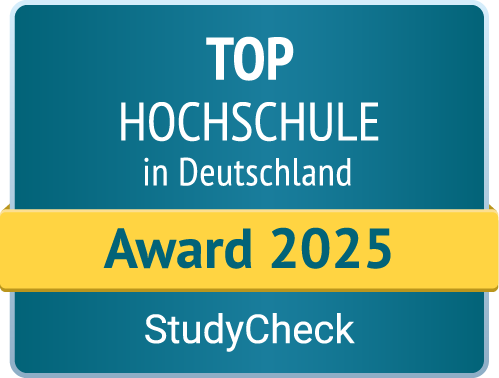- Bachelor
- Applied Polymer Technology
- Applied Business and Media Psychology
- Business administration
- Biomedical Engineering
- Data Protection and IT Security
- Industrial Biotechnology
- Intercultural Management
- International Management (top athletes)
- Artificial Intelligence and Cognitive Systems
- Multimedia and Communication
- Sustainable Engineering
- Master
- Applied Artificial Intelligence and Digital Transformation
- Applied Biotechnology
- Applied Research in Engineering Sciences
- Data Governance and Ethics
- Digital Learning
- Digital Marketing
- Energy Management and Energy Technology
- Innovation and Entrepreneurship
- International Product and Service Management
- Creative Management
- Further education
- Research
- University
- Service
- Jobs
-
-
-
-
-
-
-
Laboratories Technology
Additive manufacturing
Additive manufacturing (AM), also known as 3D printing, is an innovative manufacturing process that has undergone rapid development in recent years. It can now be found in almost all areas of life, from the hobby sector to medical technology and industrial applications, from simple to sophisticated geometries and from microscopically small to very large.
The technology is based on the layer-by-layer construction of components from powdered material, filament or resin. A wide variety of 3D printers and materials are available on the market. Additive manufacturing (3D printing) makes it possible to produce prototypes, small series or functional components.
The additive manufacturing laboratory is available to students for internships and final theses. It also offers industrial companies attractive prospects for research and cooperation projects. Ansbach University of Applied Sciences thus not only promotes teaching and innovative research, but also practical collaboration with industry.
An overview of the best-known processes that are also represented in the Additive Manufacturing lab:
Fused Deposition Modelling (FDM):
FDM or Fused Filament Fabrication (FFF), is an additive manufacturing process in which an object is built up layer by layer from a filament.
Stereolithography process (SLA/DLP/LCD):
The SLA process uses a liquid synthetic resin that is cured layer by layer using a UV laser/light. This process offers a high level of precision and detail.
Selective laser sintering (SLS):
The SLS process is based on a powder material that is selectively melted by a high-precision laser. This produces functional components with high precision and detailed geometry.Equipment (according to procedure)
FDM:
Creator 4
from Flashforge
Technology: FDM/FFF IDEX
Print volume: 400 x 350 x 500 mm
Layer height: 0.05 - 0.4 mm
Print accuracy: +/- 0.2 mm
Print speed: 10-200 mm/s
Max. Platform temperature: 130°C
Max. Chamber temperature: 65°C
Max. Extruder temperature: HT: 320°C; HS: 360°C
Monitoring: Live cameraUltimaker 2+
Technology: FDM/FFF, single extruder
Print volume: 223 x 223 x 205 mm
Layer height: 0.02 mm
Print quality: 0.02 mm (depending on selected nozzle)
Print speed: 30-300 mm/s
Max. Platform temperature: up to 100°C
Max. Extruder temperature: up to 260°CUltimaker 3
Technology: FDM/FFF, dual-extrusion
Print volume: 215 x 215 x 200 mm
Layer height: 0.02 mm
Print quality: 0.02 mm (depending on selected nozzle)
Print speed: 30-300 mm/s
Max. Platform temperature: up to 100°C
Max. Extruder temperature: up to 280°C
Monitoring: Live camera
BCN Sigmax 19
Technology: FDM/FFF independent dual extruder (IDEX)
Print volume: 420 x 297 x 210 mm
Layer height: 0.05 - 0.5 mm
XY accuracy: 12.5 µm
Z accuracy: 1 µm
Print speed: up to 120 mm/s
Max. Platform temperature: 100°C
Max. Extruder temperature: max. 290°C
SLS:Sinterit LISA PRO
Technology: SLS
Laser system: IR laser diode 5 [W]; λ =808 [nm].
Print volume: 150 x 200 x 260 mm
The layer height Z (min. - max.): 0.075 - 0.175 mm
XY accuracy: 0.05 mm
Z accuracy: 1 µm
Max. Temperature in the chamber 200 °C
Nitrogen chamber embeddedSLA:
Phrozen Sonic Mighty 8K Resin
Technology: LCD (8K Resolution with Maximised Productivity)
Print volume: 218 x 123 x 235 mm
XY Resolution: 28 µm
Layer Thickness: 0.01-0.30 mm
Maximum printing speed: 70 mm/hr
Precision micro 3D printer:Giga 25vx
from Nano Dimension
Technology: DLP (Digital Light Processing)
Build volume: 12 x 18 x 50 mm
Layer height: 1 - 10 µm
Optical precision (x/y): 8 µm
Surface roughness (Ra): 0.9 µm
Further laboratory equipment:
Composer 450 filament maker and 3D printing polymer dryer from 3devo(All data without guarantee.)
Campus Ansbach Room 51.1.25 Study programmes WIG, NIW, AKT, BMT, WIN/SIM Contact persons Prof. Dr.-Ing. Alexandru Sover
Phone: +49 (0) 981 4877-527
E-Mail: a.sover(at)hs-ansbach.de© 2025 Hochschule Ansbach








